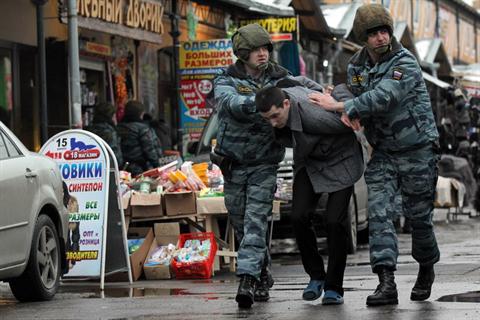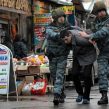
Facing the “Permanent Arab Spring”: Terrorism and Russia’s Evolving Threat Assessment
Publication: Terrorism Monitor Volume: 11 Issue: 6
By:

The extensive and ever-proliferating literature on terrorism since 2001 remains overwhelmingly West-centric in character. Much less is written or known about terrorist threats in areas where the West is not engaged, such as the Russian North Caucasus region. Neither has Russia been able or willing to publish a threat assessment or strategic document relating to how it sees and deals with the terrorist threat. Until now, its assessments, though mentioning terrorism, have all been subordinated to the notion of a big conventional and potentially nuclear war incited by the West or (though never identified as such) by China. However, that may be changing.
This change is not a planned one but is clearly being forced by events – civil war in Libya and Syria, terrorist actions in Mali and Algeria, widespread fears about what will happen in Afghanistan and Central Asia when the U.S. military leaves in 2014 and Moscow’s utter failure to find a solution to its own “homegrown insurgency” in the North Caucasus. [1] The Russian press has reported a number of developments related to Russia’s re-evaluation of existing and potential terrorist threats and responses:
- An increasing involvement of the regular army in the suppression of the North Caucasus insurgency that has hitherto largely been left to the Internal Troops of the Ministry of the Interior (Vnutrenniye Voiska Ministerstva Vnutrennikh Del, VVMVD), who clearly have failed in their mission;
- The discussion of a new legislative agenda defining the role of the military in domestic uprisings of this sort;
- The stated intention of the new Minister of Defense, Sergei Shoigu, to transform Russia’s Airborne paratroopers (Vozdushno-desantnye voyska – VDV) into a clearly designated rapid-reaction force;
- Chief of Staff Valery Gerasimov’s open statements that Russian military modernization and exercises are now clearly linked to the experience of combat operations growing out of the Arab Spring. [2]
Exercises like 2011’s Operation Tsentr (“Center”) also presented Russian troops with missions growing out of the Arab Spring, namely operations “to stabilize the situation” in Central Asia after a hypothetical uprising had occurred (RIA Novosti, September 11, 2011). However, the difference between 2011 and 2013 is apparent if one follows Russian defense policy closely. In that literature we have heard very little at all for the last 24 months (except for the aforementioned fears about Central Asia) about the military-political threat posed to Russia from terrorism in the North Caucasus or the lessons presented by the fighting in the Middle East. Although there was much concern in Moscow early on that the Arab Spring might spread to Central Asia, that was a political, not a military threat, and as time went on those fears ebbed as no Central Asian uprisings took place. [3]
Now, however, Russian thinking on terrorist issues has begun to change as the Sochi Winter Olympics draw closer. While this event already shows signs of becoming an epic disaster due to corruption, mismanagement and terrorist activity in the North Caucasus, Russia’s security officials also find themselves challenged by the ever-growing brutality in Syria, the consequences of the Western withdrawal from Afghanistan and the spread of terrorism to Algeria and Mali (which Moscow clearly blames on the Western intervention in Libya).
Whereas what we saw in 2011 was merely the addition of a new mission for the troops, we may now be in the early stages of a process of rethinking terrorism and war that will not only affect the armed forces’ missions, and training, but also force structure, the procurement of weapons and technologies and, perhaps most importantly, threat assessments and doctrines.
Andrei Novikov, head of the Commonwealth of Independent States (CIS) Anti- Terrorist Center, recently warned that the decision to pull U.S. and ISAF troops out of Afghanistan in 2014 had created a new strategic situation in Central Asia and Afghanistan. He warned that terrorist and guerilla activity in Afghanistan once ISAF and the United States leave may devolve into a struggle for control of the nation’s raw materials and energy resources to the exclusion of foreign businesses or governments (Interfax, February 12; FBIS SOV, February 12).
Terrorism in Central Asia may thus become rooted in a struggle for the re-division of Afghan and Pakistani natural resources and control of projected pipelines like the Turkmenistan-Afghanistan-Pakistan-India (TAPI) pipeline. Undoubtedly, such concerns apply with equal force to the possibility of terrorist activity, not only in the North Caucasus, but in the South Caucasus as well. Moreover, Novikov extrapolates more generally from these terrorist campaigns and the ongoing civil strife in Syria and the Middle East to argue that terrorism is increasingly being used as an instrument of policy (i.e. by the United States and its allies), an instrument for settling problems in large-scale infrastructural projects and as a means of determining economic relations between rival clans in these conflict theaters. Thus terrorists and/or mercenaries attack the infrastructure of sovereign states on a regular basis. But things do not end there. According to Novikov, and no doubt many of his colleagues, “We are dealing with a new type of state crisis whose models and techniques have been tested. These are the permanent “Arab Spring” and crises of the “Syrian scenario;” actually we are witnessing local armed conflicts” (Interfax, February 12; FBIS SOV, February 12).
Thus Novikov implicitly ties together the North Caucasus, Afghanistan and the Arab Spring (in keeping with official Russian statements) as being at the same time terrorist manifestations and the outcome of deliberate actions against Russia or its allies by other states (presumably the United States and its allies).
When we take into account the mounting signs of political unrest in both Azerbaijan and Armenia on top of all these other actual or potential crises, the danger to the Russian heartland becomes clear. [4] Indeed, it has been clear already for several months that the insurgency in the North Caucasus has spread into such core Russian territories as Kazan on the Volga and the Urals, so the danger of insurgencies along Russia’s southern periphery spreading into its heartland is hardly negligible. Of course, if a rethinking of the threat assessment and of the proper role of the armed forces in fighting this threat is underway, as we believe, it is only in its first stages and the outcome of the process cannot be determined from here at this precise moment. Nevertheless a discernible and measurable change in Russian threat assessments, characterizations of contemporary warfare and new missions for the armed forces should have profound repercussions for Russia’s counter-terrorist efforts, overall defense posture and national security policy. If indeed Russia is rethinking the nature of the threats it faces and of contemporary warfare, that is a process that could have significant implications far beyond Russia’s borders. This is therefore a trend that bears careful scrutiny in the immediate future.
Notes
1. See Stephen Blank, ed., Russia’s Homegrown Insurgency: Jihad in the North Caucasus, Strategic Studies Institute, U.S. Army War College, October, 2012.
2. Andrei Polunin, “Olympic Unease: With a Year to go Sochi Games Feverishly Attempting to Achieve Stability in North Caucasus,” Moscow, Svobodnaya Pressa, in Russian, February 18, 2013, Open source Center, Foreign Broadcast Information Center, Central Eurasia, (henceforth, FBIS SOV), February 18, 2013; Moscow, RIA Novosti Online, in Russian, February 27, 2013, FBIS SOV, February 27, 2013; Roger McDermott, “Gerasimov Links Russian Military Modernization to the Arab Spring,” Eurasia Daily Monitor, March 5, 2013.
3. Sokhranit’ Stabilnost’ v Tsentral’noi Azii- Uchastniki Parlametnariskikh Situatsii v Gosdume,” www.duma.gov.ru/news/273/71937/print=yes, April 13, 2011.
4. Lili Dobrovolskaya, “Is an Apricot Revolution in Armenia Realistic?” Moscow, Slon, in Russian, February 26, 2013, FBIS SOV, February 26, 2013.
The views expressed here do not represent those of the U.S. Army, Defense Department, or the U.S. Government





